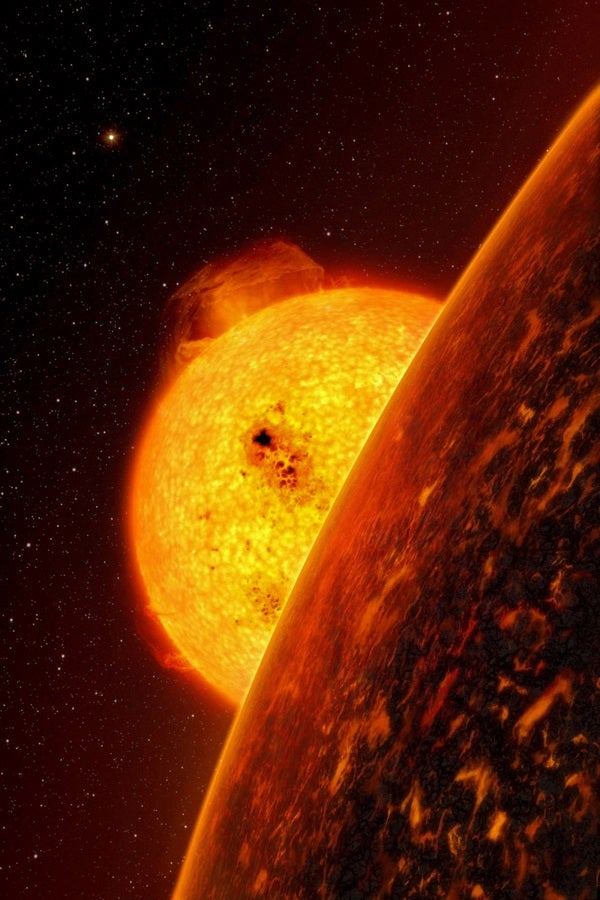When scientists confirmed in October that they had detected the first rocky planet outside our solar system, it advanced the longtime quest to find an earthlike planet hospitable to life.
Rocky planets — Earth, Mercury, Venus, and Mars — make up half the planets in our solar system. Scientists consider rocky planets better environments to support life than planets that are mainly gaseous, like the other half of the planets in our system: Jupiter, Saturn, Uranus, and Neptune.
Astronomers discovered the rocky planet CoRoT-7b circling a star some 480 light-years from Earth. It is, however, a forbidding place and unlikely to harbor life. That’s because it is so close to its star that temperatures might be above 4000° Fahrenheit (2,200° Celsius) on the surface lit by its star and as low as –350° F (–210° C) on its dark side.
Now scientists led by a University of Washington astronomer say that if CoRoT-7b’s orbit is not almost perfectly circular, then the planet might also be undergoing fierce volcanic eruptions. It could be even more volcanically active than Jupiter’s moon Io, which has more than 400 volcanoes and is the most geologically active object in our solar system.
“If conditions are what we speculate, then CoRoT-7b could have multiple volcanoes going off continuously and magma flowing all over the surface,” said Rory Barnes, a University of Washington postdoctoral researcher of astronomy and astrobiology. Any planet where the surface is being remade at such a rate is a place nearly impossible for life to get a foothold, he said.
Calculations about CoRoT-7b’s orbit and probable volcanism were presented at the American Astronomical Society meeting in Washington, D.C., during a session January 5 and as part of a press briefing January 6. The presenters included Barnes; Sean Raymond, University of Colorado, Boulder; Richard Greenberg, University of Arizona; Nathan Kaib, a NASA postdoctoral program fellow at the University of Washington; and Brian Jackson, NASA’s Goddard Space Flight Center, Greenbelt, Maryland. CoRoT-7 b was discovered by a French-led team using the CoRoT — Convection, Rotation and Planetary Transits — satellite.
The next step to finding a planet that harbors life may have to wait until astronomers are better able to detect rocky planets that are farther from their stars, Barnes said. “Because it is easier to detect planets that orbit close to their host stars, a significant fraction of the first wave of rocky planets being found outside our solar system may be more Io-like than earthlike.”
Barnes and his colleagues suspect CoRoT-7b is subject to extreme volcanism partly because it is so close to its sun, the distance between the two being about 1.6 million miles (2.5 million kilometers). That’s about 60 times closer than Earth is to the Sun.
Volcanism is then triggered by even a tiny deviation from a circular orbit. How tiny of a deviation? About 155 miles (250 km), according to calculations done by Barnes based on how bodies in our solar system influence each other’s orbits. That’s about the distance from Washington, D.C., to Philadelphia. That amount of deviation, or more, could be caused by the gravitational pull of the next planet out from CoRoT-7b.
Deviations in its orbit would set tidal forces in motion that flex and distort the whole shape of CoRoT-7b. This is different from what happens on Earth, where oceans absorb the energy of tidal forces.
“CoRoT-7b most certainly has no oceans,” Barnes said. “A planet on a non-circular orbit experiences different amounts of gravitational force at different points along the orbit, feeling the strongest gravitational pull when it is closest to the star and the weakest when it is most distant. As the planet moves between these two points, it stretches and relaxes. This flexing produces friction that heats the interior of the planet resulting in volcanism on the surface.
“This scenario is exactly what is occurring on Jupiter’s moon Io. For planets like CoRoT-7b, however, the heating may be much, much stronger than on Io.”










